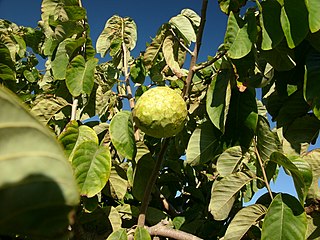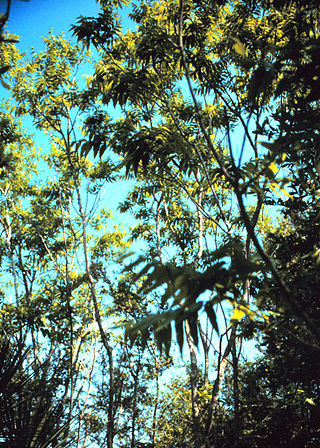
Asimina is a genus of small trees or shrubs described as a genus in 1763. Asimina is the only temperate genus in the tropical and subtropical flowering plant family Annonaceae. Asimina have large, simple leaves and large fruit. It is native to eastern North America and collectively referred to as pawpaw. The genus includes the widespread common pawpaw Asimina triloba, which bears the largest edible fruit indigenous to the United States. Pawpaws are native to 26 states of the U.S. and to Ontario in Canada. The common pawpaw is a patch-forming (clonal) understory tree found in well-drained, deep, fertile bottomland and hilly upland habitat. Pawpaws are in the same plant family (Annonaceae) as the custard apple, cherimoya, sweetsop, soursop, and ylang-ylang; the genus is the only member of that family not confined to the tropics. Fossils date to the Cretaceous.

Soursop is the fruit of Annona muricata, a broadleaf, flowering, evergreen tree. It is native to the tropical regions of the Americas and the Caribbean and is widely propagated. It is in the same genus, Annona, as with cherimoya and custard apple and is in the Annonaceae family.

The Annonaceae are a family of flowering plants consisting of trees, shrubs, or rarely lianas commonly known as the custard apple family or soursop family. With 108 accepted genera and about 2400 known species, it is the largest family in the Magnoliales. Several genera produce edible fruit, most notably Annona, Anonidium, Asimina, Rollinia, and Uvaria. Its type genus is Annona. The family is concentrated in the tropics, with few species found in temperate regions. About 900 species are Neotropical, 450 are Afrotropical, and the remaining are Indomalayan.

The cherimoya, also spelled chirimoya and called chirimuya by the Inca people, is a species of edible fruit-bearing plant in the genus Annona, from the family Annonaceae, which includes the closely related sweetsop and soursop. The plant has long been believed to be native to Ecuador and Peru, with cultivation practised in the Andes and Central America, although a recent hypothesis postulates Central America as the origin instead, because many of the plant's wild relatives occur in this area.

Annona or Anona is a genus of flowering plants in the pawpaw/sugar apple family, Annonaceae. It is the second largest genus in the family after Guatteria, containing approximately 166 species of mostly Neotropical and Afrotropical trees and shrubs.

Annona reticulata is a small deciduous or semi-evergreen tree in the plant family Annonaceae. It is best known for its fruit, called custard apple, a common name shared with fruits of several other species in the same genus: A. cherimola and A. squamosa. Other English common names include ox heart and bullock's heart. The fruit is sweet and useful in preparation of desserts, but is generally less popular for eating than that of A. cherimola.

Annona squamosa is a small, well-branched tree or shrub from the family Annonaceae that bears edible fruits called sugar apples or sweetsops. It tolerates a tropical lowland climate better than its relatives Annona reticulata and Annona cherimola helping make it the most widely cultivated of these species. Annona squamosa is a small, semi-(or late) deciduous, much-branched shrub or small tree 3 to 8 metres tall similar to soursop. It is native of tropical climate in the Americas and West Indies, and Spanish traders aboard the Manila galleons docking in the Philippines brought it to Asia.

Sapindus is a genus of about thirteen species of shrubs and small trees in the lychee family, Sapindaceae and tribe Sapindeae. It is native to warm temperate to tropical regions of the world. The genus includes both deciduous and evergreen species. Members of the genus are commonly known as soapberries or soapnuts because the fruit pulp is used to make soap. The generic name is derived from the Latin words sapo, meaning "soap", and indicus, meaning "of India".

Annona glabra is a tropical fruit tree in the family Annonaceae, in the same genus as the soursop and cherimoya. Common names include pond apple, alligator apple, swamp apple, corkwood, bobwood, and monkey apple. The tree is native to Florida in the United States, the Caribbean, Central and South America, and West Africa. It is common in the Everglades. The A. glabra tree is considered an invasive species in Sri Lanka and Australia. It grows in swamps, is tolerant of saltwater, and cannot grow in dry soil.

Asimina triloba, the American papaw, pawpaw, paw paw, or paw-paw, among many regional names, is a small deciduous tree native to the eastern United States and southern Ontario, Canada, producing a large, yellowish-green to brown fruit. Asimina is the only temperate genus in the tropical and subtropical flowering plant family Annonaceae, and Asimina triloba has the most northern range of all. Well-known tropical fruits of different genera in family Annonaceae include the custard-apple, cherimoya, sweetsop, ylang-ylang, and soursop.

Annona montana, the mountain soursop, is a tree and its edible fruit in the Annonaceae family native to Central America, the Amazon, and islands in the Caribbean. It has fibrous fruits. A. montana may be used as a rootstock for cultivated Annonas.

Rollinia is a genus of plants in the family Annonaceae. While it is widely recognised as a distinct genus a monograph published in 2006 advocates its inclusion in Annona, which also contains custard apples and soursops.

Monodora is a genus of plant in family Annonaceae. It contains approximately 15 species, distributed throughout tropical Africa.

Annonacin is a chemical compound with toxic effects, especially in the nervous system, found in some fruits such as the paw paw, custard apples, soursop, and others from the family Annonaceae. It is a member of the class of compounds known as acetogenins. Annonacin-containing fruit products are regularly consumed throughout the West Indies for their traditional medicine uses.

Annona senegalensis, commonly known as African custard-apple, wild custard apple, wild soursop, abo ibobo, sunkungo, and dorgot is a species of flowering plant in the custard apple family, Annonaceae. The specific epithet, senegalensis, translates to mean "of Senegal", the country where the type specimen was collected.

The atemoya, Annona × atemoya, or Annona squamosa × Annona cherimola is a hybrid of two fruits – the sugar-apple and the cherimoya – which are both native to the American tropics. This fruit is popular in Taiwan, where it is known as the "pineapple sugar apple" (鳳梨釋迦), so it is sometimes wrongly believed to be a cross between the sugar-apple and the pineapple. In Cuba it is known as anón, and in Venezuela chirimorinon. In Lebanon, the fruit is called achta. In Tanzania it is called stafeli dogo. In Brazil, the atemoya became popular and in 2011, around 1,200 hectares of atemoia were cultivated in Brazil. In Taiwan, the cultivating area of atemoya was 2,856.46 hectares in 2020, and Taitung County was the major place of cultivating.

Annona crassiflora, commonly known as marolo, araticum cortiça, araticum do cerrado or bruto, is a flowering plant in the Annonaceae family. The flowers of a marolo look like jellyfish wearing hats, and the fruits are sweet and very rough. It is native to Brazil and Paraguay and the fruit is eaten by native peoples in the Brazilian Cerrado. Although it is considered to have potential for cultivation, it has not been domesticated to date.
Annona scleroderma is a species of tree in the Annonaceae family, with an edible fruit the size of an orange. The cream-colored flesh of the fruit has a creamy banana-pineapple flavor and a soft texture. The fruit's tough skin makes it easy to handle. The fruit is little known outside its native region. The tree reaches 15 to 20 meters tall. Its pollen is shed as permanent tetrads.

Annona salzmannii, the beach sugar apple, is a tree native to Brazil.

















